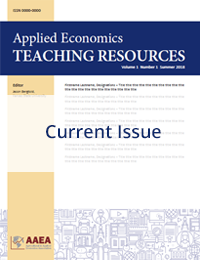Teaching and Educational Methods
Solving Optimal Groundwater Problems with Excel
Christopher A. Wada(a), Sittidaj Pongkijvorasin(b), James A. Roumasset(c), and Kimberly M. Burnett(a)
(a)University of Hawai‘i Economic Research Organization, (b)Chulalongkorn University, (c)University of Hawai‘i at Manoa,
JEL Codes: A2, A22, Q2, Q25
Keywords: Coastal aquifers, dynamic optimization, Excel Solver, groundwater management, sustainable yield
First Published Online: August 7, 2023
View Full Article (PDF) | Request Teaching Notes/Supplemental Materials
Abstract
Welfare maximizing management of coastal groundwater requires a sequence of pumping targets, typically terminating with a constant withdrawal rate in the long run. In contrast, managing according to sustainable yield at best identifies the constant rate of pumping in the long run. We illustrate an accessible solution method, using Excel Solver to find the optimal transition paths of groundwater pumping, price, and head level and the corresponding solutions in the long run. The developed framework is applied to the Pearl Harbor Aquifer (PHA) in Hawaii using data from previous studies. Each step of the solution process is described, including setting parameter values and defining objective, variable, and constraint cells in Excel to facilitate successful replication of the results. Possible extensions are also discussed such as watershed conservation, protection of groundwater dependent ecosystems, and management of multiple aquifers.
References
Bremer, L.L., A.S. Elshall, C.A. Wada, L. Brewington, J.M.S. Delevaux, A.I. El-Kadi, C.I. Voss, and K.M. Burnett. 2021. “Effects of Land Cover and Watershed Protection Futures on Sustainable Groundwater Management in a Heavily Utilized Aquifer in Hawai‘i.” Hydrogeology Journal 29:1749–1765. https://doi.org/10.1007/s10040-021-02310-6.
Burnett, K., and C.A. Wada. 2014. “Optimal Groundwater Management When Recharge Is Declining: A Method for Valuing the Recharge Benefits of Watershed Conservation.” Environmental Economics and Policy Studies 16:263–278. https://doi.org/10.1007/s10018-014-0077-y.
Burt, O. 1966. “Economic Control of Groundwater Reserves.” Journal of Farm Economics 48(3):632–647. https://doi.org/10.2307/1236865
Chakravorty, U., and D.L. Krulce. 1994. “Heterogeneous Demand and Order of Resource Extraction.” Econometrica 62:1445–1452. https://doi.org/10.2307/2951755
Conrad, J. 1999. Resource Economics. Cambridge University Press.
Duarte, T.K., S. Pongkijvorasin, J. Roumasset, D. Amato, and K. Burnett. 2010. “Optimal Management of a Hawaiian Coastal Aquifer with Nearshore Marine Ecological Interactions.” Water Resources Research 46:W11545. https://doi.org/10.1029/2010WR009094
Elshall, A.S., A.D. Arik, A.I. El-Kadi, S. Pierce, M. Ye, K.M. Burnett, C.A. Wada, L.L. Bremer, and G. Chun. 2020. “Groundwater Sustainability: A Review of the Interactions Between Science and Policy.” Environmental Research Letters 15:093004. https://doi.org/10.1088/1748-9326/ab8e8c.
Field, B. 2015. Natural Resource Economics: An Introduction, 3rd ed. Long Grove IL: Waveland Press.
Pearce, D., and A. Markandya. 1989. “Marginal Opportunity Cost as a Planning Concept.” In G. Schramm and J.J. Warford, eds. Environmental Management and Economic Development. Baltimore MD: The Johns Hopkins University Press, pp. 39–55.
Pearce, D., and R.K. Turner. 1990. Economics of Natural Resources and the Environment. Baltimore MD: The Johns Hopkins University Press.
Perman, R., Y. Ma, J. McGilvray, and M. Common. 2003. Natural Resource and Environmental Economics, 3rd ed. Harlow UK: Pearson Education Limited.
Pongkijvorasin, S., and J. Roumasset. 2007. “Confuser Cost.” Working paper 200712, Department of Economics, University of Hawaii at Manoa. https://www.researchgate.net/publication/5082293_Confuser_Cost
Roumasset, J.A., and C.A. Wada. 2010. “Optimal and Sustainable Groundwater Extraction.” Sustainability 2:2676–2685. https://doi.org/10.3390/su2082676.
Roumasset, J.A., and C.A. Wada. 2012. “Ordering the Extraction of Renewable Resources: The Case of Multiple Aquifers.” Resource and Energy Economics 34:112–128. https://doi.org/10.1016/j.reseneeco.2011.10.003.
Roumasset, J.A., and C.A. Wada. 2013. “Economics of Groundwater.” In J.F. Shogren, ed. Encyclopedia of Energy, Natural Resource, and Environmental Economics, vol. 2. Amsterdam: Elsevier, pp. 10–21. https://doi.org/10.1016/B978-0-12-375067-9.00157-1.
Roumasset, J.A., and C.A. Wada. 2015. “Chapter 5: Integrated Groundwater Resource Management.” In A.M. Balisacan, U. Chakravorty, and M.-L.V. Ravago, eds. Sustainable Economic Development: Resources, Environment and institutions. Oxford: Academic Press, pp. 77–89. https://doi.org/10.1016/B978-0-12-800347-3.00005-4.
Texas A&M University School of Law Program in Natural Resources Systems. 2017. “Groundwater Laws and Regulations: A Preliminary Survey of Thirteen U.S. States.” DOI: 10.37419/EENRS.USStateGroundwaterLaws.2017.
Tietenberg, T.H., and L. Lewis. 2020. Natural Resource Economics: The Essentials. Routledge.
Wada, C.A., S. Pongkijvorasin, and K.M. Burnett. 2020. “Mountain-to-Sea Ecological-Resource Management: Forested Watersheds, Coastal Aquifers, and Groundwater Dependent Ecosystems.” Resource and Energy Economics 59:101146. https://doi.org/10.1016/j.reseneeco.2019.101146.
Water Science School. 2018. “Where Is Earth’s Water?” https://www.usgs.gov/special-topics/water-science- school/science/where-earths-water
World Bank. 2016. “High and Dry.” Climate Change, Water, and the Economy. Washington DC: The World Bank Group. https://www.worldbank.org/en/topic/water/publication/high-and-dry-climate-change-water-and-the-economy.
Articles in this issue
Contemporary Adjustments Needed to Teaching Water Economics in Light of Changes Facing the Water Sector and Its Users: Introduction to the Special Issue
Ariel Dinar and Mehdi Nemati
Teaching Water Economics Using Dynamics and a Political Economy Framework
David Zilberman, Scott Kaplan, Alice Huang, Lanie Goldberg
Reconciling Theory and Practice in Higher Education Water Economics Courses
Roy Brouwer
Teaching Principles of Water Economics to Non-Economists: Lessons from California
Mehdi Nemati and Ariel Dinar
Innovations for the Water Resource Economics Curriculum: Training the Next Generation
Frank A. Ward
Teaching Water Resource Economics for Policy Analysis
Bonnie Colby
Teaching Water and Sanitation Economics and Policy with a Focus on Low- and Middle-Income Countries
Dale Whittington and Duncan Andrew Thomas
Teaching Water Economics by Building Problem-Based Case Studies
David Zetland
Teaching Water Economics in a Desert Environment
Slim Zekri
Solving Optimal Groundwater Problems with Excel
Christopher A. Wada, Sittidaj Pongkijvorasin, James A. Roumasset, and Kimberly M. Burnett


